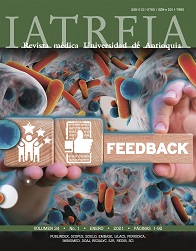Evaluation of the avidity test for the follow up on children treated for congenital toxoplasmosis during the first year of life
DOI:
https://doi.org/10.17533/udea.iatreia.70Keywords:
follow-up studies, immunoglobulin G, toxoplasmosis, congenitalAbstract
Objective: To determine the use of avidity testing in the follow up of patients diagnosed with congenital toxoplasmosis, through the observation of its behavior in time.
Methods: Retrospective study from clinical records of children with confirmed diagnosis and treatment for congenital toxoplasmosis, which took place on a toxoplasmosis consultation in the third reference level University of Quindío clinic. A total of 21 children were selected among an initial cohort of 168 patients, recruited during prenatal screening, neonatal screening or children that attended for neonatal diagnosis.
Results: There was no statistical significance found between low avidity during the first month and having received prenatal treatment (p=0,47). There was no statistical relationship either between the percentage of avidity and the levels of IgG or the months of age, despite having received postnatal treatment. Nevertheless, when studying specifically the group of children > 5 months of age a significant correlation was found with levels of IgG (p=0,01).
Conclusion: In this cohort of Colombian children with congenital toxoplasmosis, the same results were found comparing with those reported in series with greater number of cases. Avidity testing did not prove to be useful for the follow up of children with congenital toxoplasmosis.
Downloads
References
(1) Gómez Marín JE. Protozoología médica: protozoos parásitos en el contexto latinoamericano. Bogotá: Editorial El Manual Moderno; 2010.
(2) Cañón-Franco W, López-Orozco N, Gómez-Marín J, Dubey JP. An overview of seventy years of research (1944 - 2014) on toxoplasmosis in Colombia, South America. Parasit Vectors. 2014 Jan 7;(1):427. DOI 10.1186/1756-3305-7-427.
(3) Petersen E, Ajzenberg D, Mandelbrot L, Gomez-Marin JE. Protozoan Diseases: Toxoplasmosis. In: International Encyclopedia of Public Health. 2 ed. España; Elsevier; 2017. p. 114-32.
(4) Gómez J. Toxoplasmosis: un problema de Salud Pública en Colombia. Rev Salud Pública. 2002;4(Sup.2):7-10.
(5) El Bissati K, Levigne P, Lykins J, Adlaoui EB, Barkat A, Berraho A, et al. Global initiative for congenital toxoplasmosis: an observational and international comparative clinical analysis. Emerg Microbes Infect. 2018 Dec;7(1):1–14. DOI 10.1038/s41426-018-0164-4.
(6) Gómez-Marin JE, De-la-Torre A, Angel-Muller E, Rubio J, Arenas J, Osorio E, et al. First Colombian Multicentric Newborn Screening for Congenital Toxoplasmosis. PLoS Negl Trop Dis. 2011 May 31;5(5):e1195. DOI 10.1371/journal.pntd.0001195.
(7) Fallahi S, Rostami A, Nourollahpour Shiadeh M, Behniafar H, Paktinat S. An updated literature review on maternal-fetal and reproductive disorders of Toxoplasma gondii infection. J Gynecol Obstet Hum Reprod. 2018 Mar;47(3):133-40. DOI 10.1016/j.jogoh.2017.12.003.
(8) Wilson CB, Remington JS, Stagno S, Reynolds DW. Development of Adverse Sequelae in Children Born with Subclinical Congenital Toxoplasma Infection. Pediatrics. 1980 Nov;66(5):767-74.
(9) Khan K, Khan W. Congenital toxoplasmosis: An overview of the neurological and ocular manifestations. Parasitol Int. 2018 Dec;67(6):715-21. DOI 10.1016/j.parint.2018.07.004.
(10) Wallon M, Cozon G, Ecochard R, Lewin P, Peyron F. Serological rebound in congenital toxoplasmosis: long-term follow-up of 133 children. Eur J Pediatr. 2001 Sep;160(9):534-40. DOI 10.1007/s004310100805.
(11) Torres-Morales E, Gómez-Marín JE. Evaluating a toxoplasma IgG avidity ELISA test for diagnostic purposes during pregnancy and correlating it with toxoplasma IgM and IgA in the Biomedical Research Centre’s laboratory at the Universidad del Quindío, 2008. Rev Colomb Obstet Ginecol. 2008;59(3):199-205.
(12) Fricker-Hidalgo H, Cimon B, Chemla C, Darde ML, Delhaes L, L’Ollivier C, et al. Toxoplasma Seroconversion with Negative or Transient Immunoglobulin M in Pregnant Women: Myth or Reality? A French Multicenter Retrospective Study. J Clin Microbiol. 2013 Jul 1;51(7):2103-11. DOI 10.1128/JCM.00169-13.
(13) Murat J-B, L’Ollivier C, Hidalgo HF, Franck J, Pelloux H, Piarroux R. Evaluation of the New Elecsys Toxo IgG Avidity Assay for Toxoplasmosis and New Insights into the Interpretation of Avidity Results. Clin Vaccine Immunol. 2012 Nov;19(11):1838-43. DOI 10.1128/CVI.00333-12.
(14) Meroni V, Genco F, Tinelli C, Lanzarini P, Bollani L, Stronati M, et al. Spiramycin Treatment of Toxoplasma gondii Infection in Pregnant Women Impairs the Production and the Avidity Maturation of T. gondii-Specific Immunoglobulin G Antibodies. Clin Vaccine Immunol. 2009 Oct;16(10):1517-20. DOI 10.1128/CVI.00253-09.
(15) Buffolano W, Lappalainen M, Hedman L, Ciccimarra F, Del Pezzo M, Rescaldani R, et al. Delayed maturation of IgG avidity in congenital toxoplasmosis. Eur J Clin Microbiol Infect Dis. 2004 Nov;23(11):825-30. DOI 10.1007/s10096-004-1226-1.
(16) Gilbert RE, Freeman K, Lago EG, Bahia-Oliveira LMG, Tan HK, Wallon M, et al. Ocular Sequelae of Congenital Toxoplasmosis in Brazil Compared with Europe. PLoS Negl Trop Dis. 2008 Aug 13;2(8):e277. DOI 10.1371/journal.pntd.0000277.
(17) Lebech M, Joynson DHM, Seitz HM, Thulliez P, Gilbert RE, Dutton GN, et al. Classification system and case definitions of Toxoplasma gondii infection in immunocompetent pregnant women and their congenitally infected offspring. Eur J Clin Microbiol Infect Dis. 1996 Oct;15(10):799-805. DOI 10.1007/BF01701522.
(18) Torres E, Rivera R, Cardona N, Sanchez V, Lora F, Gómez-Marín JE, et al. Evaluation of IgG anti-toxoplasma avidity and polymerase chain reaction in the postnatal diagnosis of congenital toxoplasmosis. Pediatr Infect Dis J. 2013 Jun;32(6):693-5. DOI 10.1097/INF.0b013e31828807a4.
Published
How to Cite
Issue
Section
License
Copyright (c) 2020 Universidad de Antioquia

This work is licensed under a Creative Commons Attribution-NonCommercial-ShareAlike 4.0 International License.
Papers published in the journal are available for use under the Creative Commons license, specifically Attribution-NonCommercial-ShareAlike 4.0 International.
The papers must be unpublished and sent exclusively to the Journal Iatreia; the author uploading the contribution is required to submit two fully completed formats: article submission and authorship responsibility.














